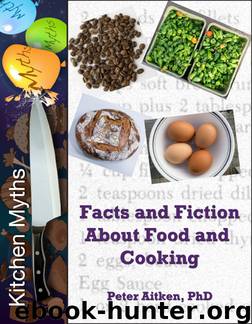Kitchen Myths by Peter Aitken

Author:Peter Aitken
Language: eng
Format: epub
Publisher: Piedmont Medical Writers LLC
Published: 2013-03-24T16:00:00+00:00
Green peppers for sale at farmers market.
All thickening agents are created equal.
A common technique in cooking is to use a starch to thicken a liquid such as a gravy or sauce. Wheat starch (flour) and corn starch are perhaps the most common, but potato starch, arrowroot, and tapioca are also used. Does it matter which one you use? Most definitely. These agents differ in five ways.
• Flavor: Does the thickening agent add its own flavor to the sauce or is it neutral in taste?
• Thickening power: Just how thick can you go?
• Consistency: The molecular structure of some starches results in long strands that can give the sauce a stringy texture.
• Stability: Will the sauce remain thick with long cooking or will it thin out?
• Appearance: Is the resulting sauce clear or opaque?
Now let’s look at how the various thickening agents stack up:
• Wheat (flour): smooth consistency, low maximum thickness, good stability, strong flavor (which can be greatly reduced by cooking the flour in fat before adding to the liquid), and opaque appearance
• Corn starch: smooth consistency, moderate maximum thickness, moderate stability, strong flavor, and opaque appearance
• Potato starch: stringy consistency, very high maximum thickness, poor stability, mild flavor, and clear appearance
• Tapioca flour: stringy consistency, high maximum thickness, poor stability, no flavor, and clear appearance
• Arrowroot: stringy consistency, high maximum thickness, good stability, no flavor, and clear appearance
Download
This site does not store any files on its server. We only index and link to content provided by other sites. Please contact the content providers to delete copyright contents if any and email us, we'll remove relevant links or contents immediately.
Unwinding Anxiety by Judson Brewer(72771)
The Art of Coaching by Elena Aguilar(52942)
The Fast Metabolism Diet Cookbook by Haylie Pomroy(21066)
Rewire Your Anxious Brain by Catherine M. Pittman(18552)
Healthy Aging For Dummies by Brent Agin & Sharon Perkins RN(16998)
Talking to Strangers by Malcolm Gladwell(13222)
The Art of Thinking Clearly by Rolf Dobelli(10220)
Mindhunter: Inside the FBI's Elite Serial Crime Unit by John E. Douglas & Mark Olshaker(9200)
Crazy Rich Asians by Kevin Kwan(9167)
The Compound Effect by Darren Hardy(8808)
Tools of Titans by Timothy Ferriss(8218)
Periodization Training for Sports by Tudor Bompa(8170)
Becoming Supernatural by Dr. Joe Dispenza(8119)
Wonder by R. J. Palacio(8010)
Crystal Healing for Women by Mariah K. Lyons(7855)
Bodyweight Strength Training by Jay Cardiello(7841)
Therapeutic Modalities for Musculoskeletal Injuries, 4E by Craig R. Denegar & Ethan Saliba & Susan Saliba(7688)
Change Your Questions, Change Your Life by Marilee Adams(7635)
Nudge - Improving Decisions about Health, Wealth, and Happiness by Thaler Sunstein(7615)
